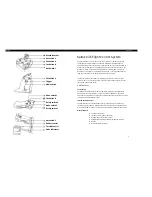
Geophysical Survey Systems, Inc.
SIR® 30
Manual
MN 93-101 Rev E
81
Figure 121: Bi-Static offset – Offset 30 cm.
Diagrammatically this is presented in Figure 122 below. As the antenna separation increases from their
initial offset (‘zero offset’) the travel time for the airwave, the ground wave, the head wave (not show) and
the reflected wave should ‘move out’ in time i.e. the distance and therefore the travel time of the various
wave fronts are increased.
Figure 122: Bistatic Data collection.
There are several decisions the User must make regarding time range and gain settings. All of these are
dependent upon the goals of the survey and type of data to be collected. If the objective is to collect
bistatic fixed offset data (in time or distance mode), then the User would at this point make an adjustment
for the gain at the increased offset distance as required (Figure 123 below).
For Common Mid Point CMP and Wide Angle Refraction, Reflection (WARR) surveys, the signal gain,
signal position and time range must be adjusted by the User as survey goals and field conditions require.
For CMP and WARR surveys, the User must determine the appropriate offset step spacing and the
minimum and maximum offset distances. The desired spacing between discrete readings in the CMP and
WARR modes is dependent on the center frequency of the antenna(s) and the electrical properties (
ε
) of
Summary of Contents for SIR 30
Page 1: ......
Page 4: ...Geophysical Survey Systems Inc SIR 30 Manual ...
Page 6: ......
Page 90: ...Geophysical Survey Systems Inc SIR 30 Manual MN 93 101 Rev E 84 ...
Page 102: ...Geophysical Survey Systems Inc SIR 30 Manual MN 93 101 Rev E 96 ...
Page 120: ...Geophysical Survey Systems Inc SIR 30 Manual MN 93 101 Rev E 114 ...
Page 122: ...Geophysical Survey Systems Inc SIR 30 Manual MN 93 101 Rev E 116 ...
Page 148: ...Geophysical Survey Systems Inc SIR 30 Manual MN 93 101 Rev E 142 ...
















































